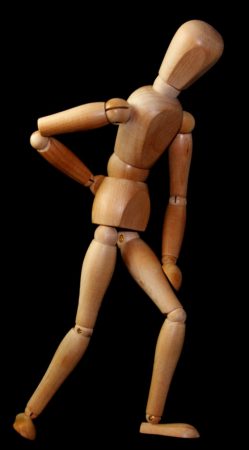
There is nothing more frustrating than that nagging pain or injury that keeps coming back. It can disrupt fitness goals, derail leisure activities and make everyday life miserable.
Many with recurrent pain or injury blame their body. “I’ve got a bad back that keeps going out, why won’t it stay in?” “That’s my bad shoulder, it always acts up and aches and I can’t sleep on it!” This kind of language places the reason for our pain outside of our control and renders us helpless. Usually, this is not the case!
We don’t want to face the fact that we are the captain of our own ship and it’s our job not to steer it into trouble. Or, that our habits and lifestyle are what can make it feel like a sinking ship. We can’t just blame “getting older.”
In many cases, our lifestyle and movement habits are overloading, weakening, or injuring tissues and causing long-term degenerative changes. Changing habits is hard.
5 reasons for recurring injury or pain
Poor movement habits and posture
We are surrounded by poor movement habits. We see relaxation as slouching and sinking into our couches and chairs.
Sometimes it’s a poorly informed movement habit, such as sitting up too straight to please parents at the dinner table or vanity causing us to suck in our stomachs, turning off our core (yes you read that correctly). Poor movement habits may not be the direct cause of pain and pathology, but they fuel the fire.
Poor conditioning
Life is an athletic event. Certain levels of baseline endurance, strength, and overall tissue constitution are required to accomplish the things in our daily everyday routine. Even simple tasks such as navigating up and down the stairs, picking up children, lugging groceries, and vacuuming the house, all require baseline levels of physical fitness.
When the activities of our daily life demand more than our muscles, tendons, and ligaments have strength for, we begin to compensate (or overcompensate) and tissues can become overloaded and painful.
Poor Ergonomics
No matter your fitness level or your movement quality, you adapt to the environment you live in. Our jobs have become more sedentary.
When you sit at a desk you can’t help but morph into the shape of the chair and lean over your desk to focus on your work. Our necks are perpetually forward and flexed from computers and smartphones.
Those lucky enough to have physical jobs that allow for more movement often fail to place themselves in proper lifting, or work positions and workstations are rarely at an optimal height.
Poor movement quality
In response to poor movement, conditioning, ergonomics, and more, our bodies develop compensatory stability and movement strategies. These compensations result in muscle imbalances characterized by weakness of our core and tightness in our back, neck, hamstrings, and shoulders, causing nagging muscle pain.
Muscle imbalances overload joints, ligaments, and tendons and over time can lead to degenerative changes to joints and tendons.
Repetitive overload
Sometimes, despite adequate conditioning and good movement habits, we can get overuse injuries. For athletes, this may be throwing too many pitches or putting in too many miles without adequate rest and recovery time.
For the general population, this can be related to work with repetitive postures or movements. When muscles fatigue they become weak and offer less stability and protection for our joints and ligaments.
Find the solution for your pain, then own it!

Taking time to identify all the factors in someone’s life takes effort by both the patient and the health care provider. Good providers treat people, not conditions. Working through a complete assessment to identify movement quality, conditioning level and ergonomics is essential.
You can’t manage what you don’t measure. When all the facts and factors are collected and considered, a personalized efficient approach for correction can be made. This can mean education, manipulative therapies, therapeutic exercises, myofascial work, ergonomic counseling, strength training, yoga, Pilates, and more — whatever the patient needs and can include in his/her already busy life. This process is designed to empower you to right the ship, navigate the choppy waters of life and arrive at whatever destination makes you happy.
Guest post by Dr. Andrew deBethune, Chiropractor, Brown Chiropractic and Wellness Clinic

Nice article…fitness is so important, its amazing how our experiences shape our ideals about health and fitness. Iit was revolutionary when I learned that people from some areas of the world “don’t do stairs”…few if any of the building in the home country have them!
Nice article…fitness is so important, its amazing how our experiences shape our ideals about health and fitness. It was revolutionary when I learned that people from some areas of the world “don’t do stairs”…few if any of the buildings in their home countries have them!
But do they do a lot of walking or some other form of movement?
Good article! We underestimate the degree to which longterm patterns of movement have their effect.
It’s hard to be comprehensive in a blog format — but I would include undiagnosed chronic conditions. Ehlers-Danos Syndrome, for example, can take years to be diagnosed; meanwhile, the patient suffers badly, without any clear idea of how to manage their condition.
Childhood, historical and intergenerational trauma take their toll as well. Emotions get trapped in the tissues and invite chronic pain as well.
Many years ago, the Institute of Medicine did a study that estimated a $650 billion/year price tag for pain in the US. I’m sure that number is higher now. Just considering the destructive effects of the opioid/opiate crisis alone…
Great points, Jeffrey. Thank you. I know of someone who has Ehlers-Danos Syndrome and has faced many challenges (and still does). It’s nice to hear from you. I hope you are doing well.
I’m in (fabulous) PT now to heal my broken hip. One of the first things the therapist said was: Now we’re going to teach you to walk properly. I had to laugh, but using a rolling motion (instead of a flat-footed plop) does help the entire body. Live and learn.
I think you need to add a video so we’ll all know how to do it right!